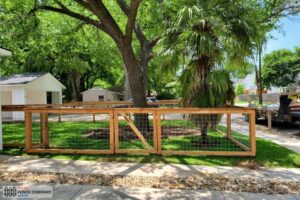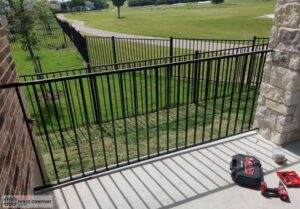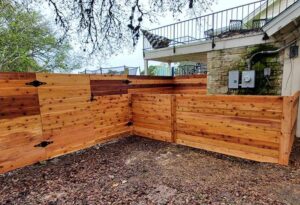Austin Fence Warranty Guide: Terms, Transfers & Fine Print
TL;DR
Most fence “warranties” are a stack of separate promises: the workmanship guarantee from your installer, material warranties for metal/composite/hardware/finishes, and optional component coverage for gate operators. The key variables are start date, labor inclusion, transfer rules, maintenance requirements, and exclusions (including storms, soil movement, and chemical exposure). Read the scope, register materials as required, and maintain a simple log with photos. In Austin’s heat, UV rays, expansive clays, and pop-up storms, the smartest warranty is the one designed to be easy to maintain.
Table of Contents
ToggleWhy warranties matter in Austin
When you build or refresh a fence in Central Texas, a warranty is only as good as the site conditions it anticipates. With guidance from your Austin fence pros from the planning stage, you can align the warranty’s fine print with the realities of our climate: high UV, sustained heat, expansive clay soils east of MoPac, shallow limestone shelves in the hills, and thunderstorms that dump inches of rain in an hour. The right warranty is essentially a design toolkit—if you meet the maintenance requirements and adhere to the construction details, it’s there when you need it.
What a fence warranty actually covers (and what it doesn’t)
Workmanship (installer) coverage
- Fixes installation errors such as out-of-plumb posts, mis-hung gates, wrong fasteners, and promised drainage details that weren’t built.
- In Austin, a 1–3 year workmanship term is common. Strong policies clarify response time for punch-list items and whether hinge/latch adjustments are included.

Material warranties
- Ornamental steel/aluminum: finish warranties for abnormal chalk/peel; many require you to touch up chips to maintain coverage.
- Composite/PVC privacy: color fade/stain within stated tolerances; exclusions for heat near grills or reflective hardscape.
- Hardware: mechanical function is often covered; finish may be shorter.
- Stains/sealers: penetrating stains usually offer performance promises (no peel, moisture control) tied to maintenance cycles rather than a blanket time claim.
Gate operators and access controls
Often 1–5 years on parts; surge/lightning and water ingress are standard exclusions unless protective accessories are installed.
What it doesn’t cover by default
Storm events exceeding stated thresholds, soil movement, and owner-caused issues (such as burying bottom boards in mulch, irrigation misting the fence face, and pressure washing in a manner that forces water behind coatings).
How the warranty clock works: start dates, proration, labor
Start date
Some clocks start at substantial completion (final walkthrough), others at invoice. Components can start shipping from the manufacturer’s ship date, unless you register by a specific deadline. Registering typically aligns coverage with your installation date.
Prorated vs. non-prorated
- Non-prorated = qualifying parts replaced at full value throughout the term.
- Prorated = credit declines with time (e.g., year 8 might be 40% coverage).
Labor inclusion
Many material warranties are parts-only. The key cost swing is whether labor and trip charges are covered for warrantable fixes during your workmanship term. Clarify this in writing before you sign.
Remedy language
“Repair or replace at our discretion” is standard. Ask whether “replace” means a matching profile/color or the nearest current equivalent.
Transferability when you sell your home
A transferable warranty can boost buyer confidence.
- A one-time transfer is typical for composites and some metals, provided the new owner registers within 30 to 60 days after closing.
- Workmanship coverage may transfer, but the term itself doesn’t reset—the remainder of the coverage remains in effect.
- Expect good-standing rules: documented maintenance, paid invoices, and no open balances.
Seller tip: Keep a single PDF packet that includes the contract, invoice, product labels/QRs, color selections, and photos of post collars, base gaps, and finished runs. That one file makes the transfer painless.
Maintenance requirements that keep coverage in good standing

Meeting these is often the difference between a calm fix and a denied claim:
- Ground-line health: maintain a 2–3 inch base gap; no soil or mulch against wood.
- Footing design: crowned concrete collars (never flat) and 6–8 inches of compacted clean gravel beneath posts.
- Drying toe: a 6–12 inch decomposed-granite (DG) band along the fence toe speeds drying and stops mud backsplash.
- Irrigation control: redirect spray; mist on boards = algae, mildew, and finish failure.
- Finish rhythm: plan a penetrating stain refresh every 2–3 years on west-sun sections; avoid film-forming products unless you’re ready for the prep they need later.
- Hardware care: seasonal hinge/latch checks; touch up powder-coat chips before rust creeps under.
Want a repeatable calendar and an objective pass/fail list? Run this guide alongside the annual inspection checklist for Austin homeowners to meet (and document) the usual requirements.
Exclusions you’ll see (and how to design around them)
- Acts of God (wind/hail/trees): mitigate by breaking long runs with hidden control joints, adding top caps to calm chatter, and keeping uniform base gaps for pressure relief.
- Soil movement: expansive clay swells when wet and shrinks when dry; gravel beds under posts and crowned collars keep sockets from pumping.
- Improper installation: shallow holes in limestone, flat collars, and incorrect fasteners; workmanship coverage should pledge to correct these issues so material warranties remain valid.
- Chemicals and salts: fertilizer overspray, pool chemicals, or de-icers. Rinse promptly and direct irrigation away from fence faces.
- Finish tolerances: composite/powder-coat delta-E color allowances and “normal chalking” clauses.
- Contact with grade: any bottom board or rot board buried in soil is a quick route to voided coverage.
Design-around mindset: if the exclusions mirror everyday Austin stressors, your spec should explicitly address drainage and footing details. If you’re installing new sections, align these details with your fence build plan so the warranty stays “in bounds” from day one—fold this into your fence installation plan with clear notes for post depth, core-drill policy at shallow rock, and base-gap standards.
Comparing two bids by warranty quality
Price parity doesn’t mean risk parity. Score each proposal on:
Workmanship clarity
Term (in writing), response window for service calls, and whether labor is included for warrantable fixes during the term.
Material registrations
Will the team register composite/metal systems on your behalf and provide product labels/QRs and color specifications for future claims?
Transfer process
One-time transfer allowed? Fees and deadlines? Who preps the buyer packet?
Drainage & footing details
Crowned collars, gravel beds, minimum embedment, and core-drill policy where limestone is shallow.
Finish plan
A written stain schedule and care notes that align with Austin weather (fall/spring windows, irrigation off faces while curing).
Exclusions acknowledged
A reasonable bid clearly outlines what isn’t covered and explains how the design mitigates those risks.
If one bid is cheaper because it’s silent here, it’s likely shifting warranty risk back to you.
Claim playbook: documents, photos, and timelines

Keep a small folder
- Contract and paid invoice (these set the clock)
- Product labels/QRs + color selections
- Photos of post collars, base gaps, and clean line shots at sign-off
- A simple maintenance log (dates you rinsed, re-stained, trimmed, fixed irrigation)
Steps if something goes wrong
- Document the issue with date-stamped, wide-angle, and close-up photos; note the weather and location.
- Call the installer first for workmanship questions—they often fix or guide you through the process.
- For material claims, expect to receive a form, photos, possibly a physical sample, and proof of installation.
- Ask about temporary stabilization while a material claim is being processed.
- Confirm whether labor is included in the remedy and whether replacement is like-for-like or nearest equivalent.
Safety/process callout: Don’t lean ladders against flexible privacy panels; instead, brace them against posts. Wear eye protection when clearing debris from collar edges.
Material-specific notes (wood, metal, composite, operators)
Cedar privacy (wood)
Your protection comes from installation quality + maintenance, not a sweeping board warranty. Keep the base gap, crown collars, and follow the stain cycle. If multiple posts feel spongy at the ground line at once, schedule targeted fence repairs before movement telegraphs into entire panels.
Ornamental steel/aluminum
Finish warranties assume reasonable care. Touch up chips quickly; matte textures hide dust and heat better, reducing hand-sizzle in August.
Composite/PVC privacy
Read fade/stain tolerances and heat proximity rules near grills or reflective pavers. Expansion joints and installation gaps matter; improper gapping can void coverage.
Gate operators
Solid on parts; protect with surge suppression and weather covers. Keep accessory SKUs/serials in your folder; some have different terms.
HOA, permits, and why compliance intersects with warranty
- HOA approvals often specify colors, heights, or metal profiles. If a section must be redone to comply, warranties rarely cover the rework.
- Setbacks/easements: A fence built inside an easement may be required to be relocated later; the warranty won’t pay to relocate a compliant fence placed in the wrong spot.
- Keep the approval letter and any permit receipts with your packet—these will be handy for transfers and future claims.
Red flags in the fine print
- “Labor excluded on all claims,” even inside the workmanship term.
- “Cosmetic defects excluded,” without defining the term.
- “No coverage for movement,” with no design plan for Austin clay or shallow rock.
- “Color match not guaranteed,” with no nearest-equivalent clause.
- “Unauthorized adjustments void warranty,” without clarifying that hinge tuning and latch alignment are allowed.
If you see these, request clarifications or amendments before signing.
FAQs
Not automatically. A shorter, explicit workmanship warranty with labor-included fixes—and properly registered material coverage—often beats a long, heavily prorated parts-only promise.
Burying bottom boards, flat concrete at the post top, and irrigation spraying the fence face. Keep a base gap, crown collars, and aim spray heads away.
Penetrating stains typically offer performance expectations tied to maintenance intervals (e.g., no peel). Film-forming coatings can promise longer color life, but they require more preparation at the time of recoat.
Storms and soil movement are standard exclusions. The best fix is design: gravel beds, crowned collars, and swales/DG toes that keep water moving away from posts.
Often, yes, once. Expect a registration window (30–60 days) and proof of maintenance in good standing.
Lock In Fence Warranty Coverage That Lasts
Want warranty coverage that actually works in Austin—on paper and on the ground? We’ll map soils and drainage, specify footing details, register eligible materials, and provide a maintenance checklist that keeps your coverage valid. Get your fence estimate today or call (512) 366-8108.
